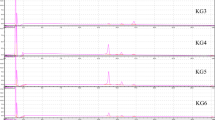Abstract
The purpose of this research was conducted to determine anthocyanin content from the grains of 10 Korean black rice varieties. Moreover, the primary constituents including protein and oil were evaluated. Anthocyanins, cyanidin-3-O-glucoside (1) and peonidin-3-O-glucoside (2), were isolated and elucidated using reversephase C18 chromatography, nuclear magnetic resonance (NMR) spectroscopy, and high performance liquid chromatography (HPLC) with diode array detection and electrospray ionization/mass spectrometry (DAD-ESI/MS). Anthocyanin showed significant differences and cyanidin-3-O-glucoside (1) (52.1±6.3-1,601.0±8.5 μg/g) exhibited a markedly higher content than peonidin-3-O-glucoside (2) (ND-82.6±1.2 μg/g). Among varieties, ‘Heugjinjubyeo’ showed the highest anthocyanin (1: 1,601.0±8.5, 2: 82.6±1.2 μg/g), whereas ‘Heughyang’ was the lowest (1: 52.1±6.3 μg/g, 2: ND). Protein and oil exhibited the minor differences and their contents ranged from 10.7±0.0 to 14.1±0.1% and from 2.1±0.0 to 2.9±0.0%. Overall results suggest that anthocyanin can be a key factor in functional property of black rice and ‘Heugjinjubyeo’ may be very important source concerning nutritional value.
Similar content being viewed by others
References
Gregorio GB, Senadhira D, Htut T, Graham RD. Improving iron an zinc value of rice for human nutrients. Agr. Develop. 23: 68–87 (1999)
Tsuda T, Watanabe M, Ohshima K, Norinobu S, Choi SW, Kawakishi S, Osawa T. Antioxidative activity of the anthocyanin pigments cyanidin-3-O-β-d-glucoside and cyanidin. J. Agr. Food Chem. 42: 2407–2410 (1994)
Chung YM, Lee JC, Kim KS, Eun JB. Chemical compositions of 26 varieties of Korean rice straw. Food Sci. Biotechnol. 10: 267–271 (2001)
Lee YR, Kim JY, Woo KS, Hwang IG, Kim KH, Kim KJ, Kim JH, Jeong HS. Changes in the chemical and functional components of Korean rough rice before and after germination. Food Sci. Biotechnol. 16: 1006–1010 (2007)
Chung HS, Woo WS. A quinolone alkaloid with antioxidant activity from the aleurone layer of anthocyanin-pigmented rice. J. Nat. Prod. 64: 1579–1580 (2001)
Lee HJ, Oh SK, Choi HC, Kim SU. Identification of anthocyanins from pigmented rice seed. Agric. Chem. Biotechnol. 41: 257–265 (1988)
Yoshinaga K, Yakahashi K, Yoshizawa K. Liquor with pigments of red rice. J. Brew. Soc. Jpn. 81: 337–342 (1986)
Ling WH, Wang LL, Ma J. Supplementation of the black rice outer fraction to rabbits decrease atherosclerotic plaque formation and increase antioxidant status. J. Nutr. 132: 20–26 (2002)
Hu C, Zawistowski J, Ling W, Kitts DD. Black rice (Oryza sativa L. indica) pigmented fraction suppresses both reactive oxygen species and nitric oxide in chemical and biological model systems. J. Agr. Food Chem. 51: 5271–5277 (2003)
Middleton Jr E, Kandaswami C, Theoharides TC. The effects of plant flavonoids on mammalian cells: Implications for inflammation, heart disease, and cancer. Pharmacol. Rev. 52: 673–751 (2000)
Jang M, Cai L, Udeani GO, Slowing KV, Thomas CF, Beecher CW, Fong HH, Farnsworth NR, Kinghorn AD, Mehta RC, Moon RC, Pezzuto. Cancer chemopreventive activity of resveratrol, a natural product derived from grapes. Science 275: 218–220 (1997)
Shim SI, Chung JW, Lee JM, Hwang KT, Sone J, Hong BS, Cho HY, Jun WJ. Hepatopotective effects of black rice on superoxide anion radicals in HepG2 Cells. Food Sci. Biotechnol. 15: 993–996 (2006)
Xia M, Ling WH, Ma J. Kitts DD, Zawistowski J. Supplementation of diets with the black rice pigment fraction attenuates atherosclerotic plaque formation in apolipoprotein E deficient mice. J. Nutr. 133: 744–751 (2002)
Chiang AN, Wu HL, Yeh HI, Chu CS, Lin HC, Lee WC. Antioxidant effects of black rice extract through the induction of superoxide dismutase and catalase activities. Lipids 41: 797–803 (2006)
Choi YM, Jeong HS, Lee JS. Antioxidant activity of methanolic extracts from some grains consumed in Korea. Food Chem. 103: 130–138 (2007)
Serrewaltthanawut I, Prapintip S, Watchiraruji K, Goto M, Sasaki M, Shotipru K. Extraction of protein and amino acids from deolled rice bran by subcritical water hydrolysis. Bioresource Technol. 99: 555–561 (2008)
Wei W, Fang-min C, Zheng-hui L, Ke-su W. Differences of phytic acid content and its relation to four protein composition contents in grains of twenty-nine japonica rice varieties from Jiangsu and Zhejiang provinces, China Rice Sci. 14: 311–314 (2007)
Vogel RA, Corretti MC, Plotnick GD. The postprandial effect of components of the Mediterranean diet on endothelial function. J. Am. Coll. Cardiol. 36: 1455–1460 (2000)
Marchesi S, Roscini AR, Lupattelli G, Siepi D, Pasqualini L, Pirro M, Vaudo G, Mannarino E. Postprandial impairment of brachial flow-mediated vasodilation after an oral fat load constituted by rice oil. Nutr. Res. 22: 1003–1007 (2002)
Kim SL, Berhow MA, Kim JT, Chi HY, Lee SJ, Chung IM. Evaluation of soyasaponin, isoflavone, protein, lipid, and free sugar accumulation in developing soybean seeds. J. Agr. Food Chem. 54: 10003–10010 (2006)
Yawadio R, Tanimori S, Morita N. Identification of phenolic compounds isolated from pigmented rices and their aldose reductase inhibitory activities. Food Chem. 101: 1616–1625 (2007)
Choi SW, Kang WW, Osawa T. Isolation and identification of anthocyanins pigments in black rice. Foods Biotechnol. 3: 131–136 (1994)
Lee JH, Kang NS, Shin SO, Shin SH, Lim SG, Suh DY, Baek IY, Park KY, Ha TJ. Characterisation of anthocyanins in the black soybean (Glycine max L.) by HPLC-DAD-ESI/MS analysis. Food Chem. 112: 226–231 (2009)
Chandi GK, Sogi DS. Functional properties of rice bran protein concentrations. J. Food Eng. 79: 592–597 (2007)
Author information
Authors and Affiliations
Corresponding author
Rights and permissions
About this article
Cite this article
Lee, J.H. Identification and quantification of anthocyanins from the grains of black rice (Oryza sativa L.) varieties. Food Sci Biotechnol 19, 391–397 (2010). https://doi.org/10.1007/s10068-010-0055-5
Received:
Revised:
Accepted:
Published:
Issue Date:
DOI: https://doi.org/10.1007/s10068-010-0055-5




